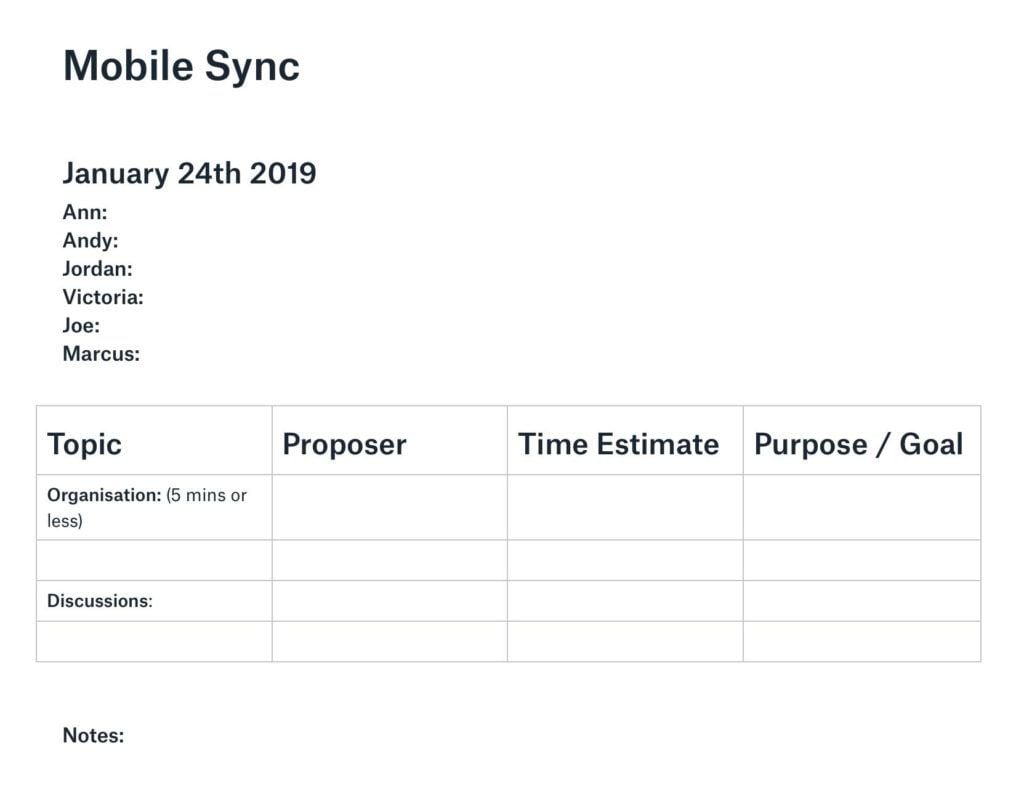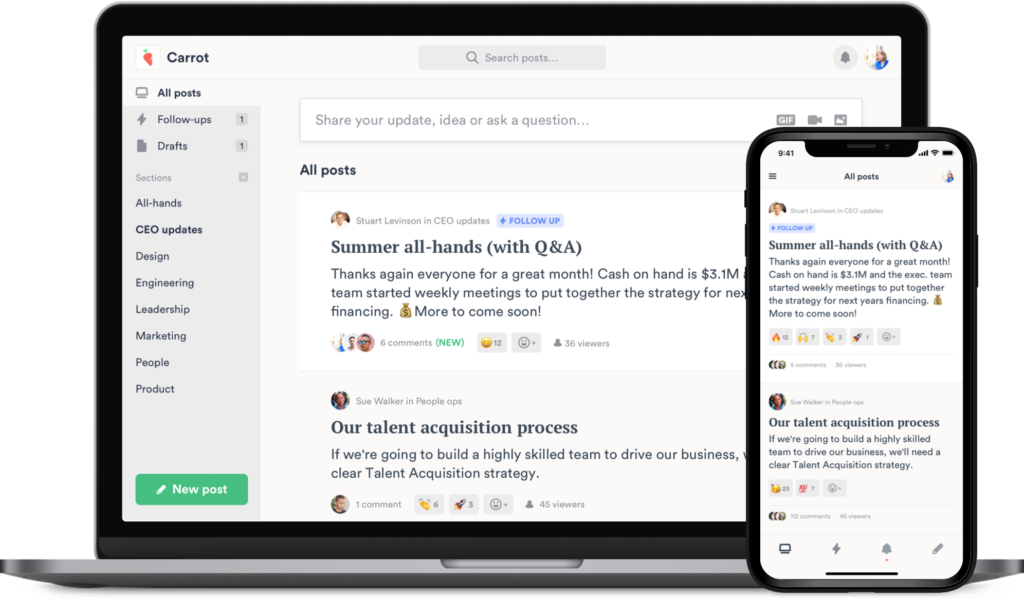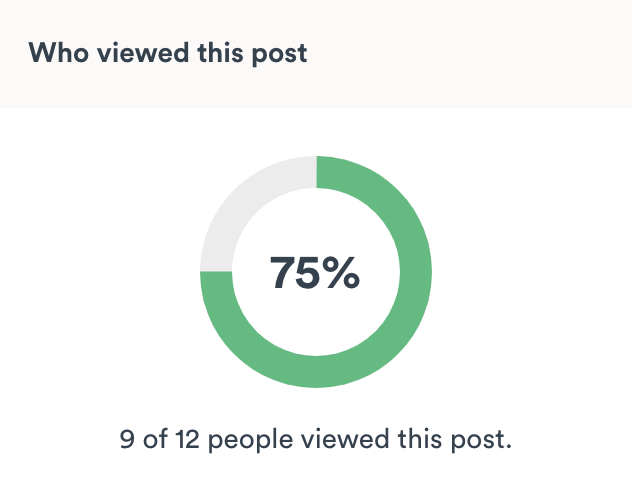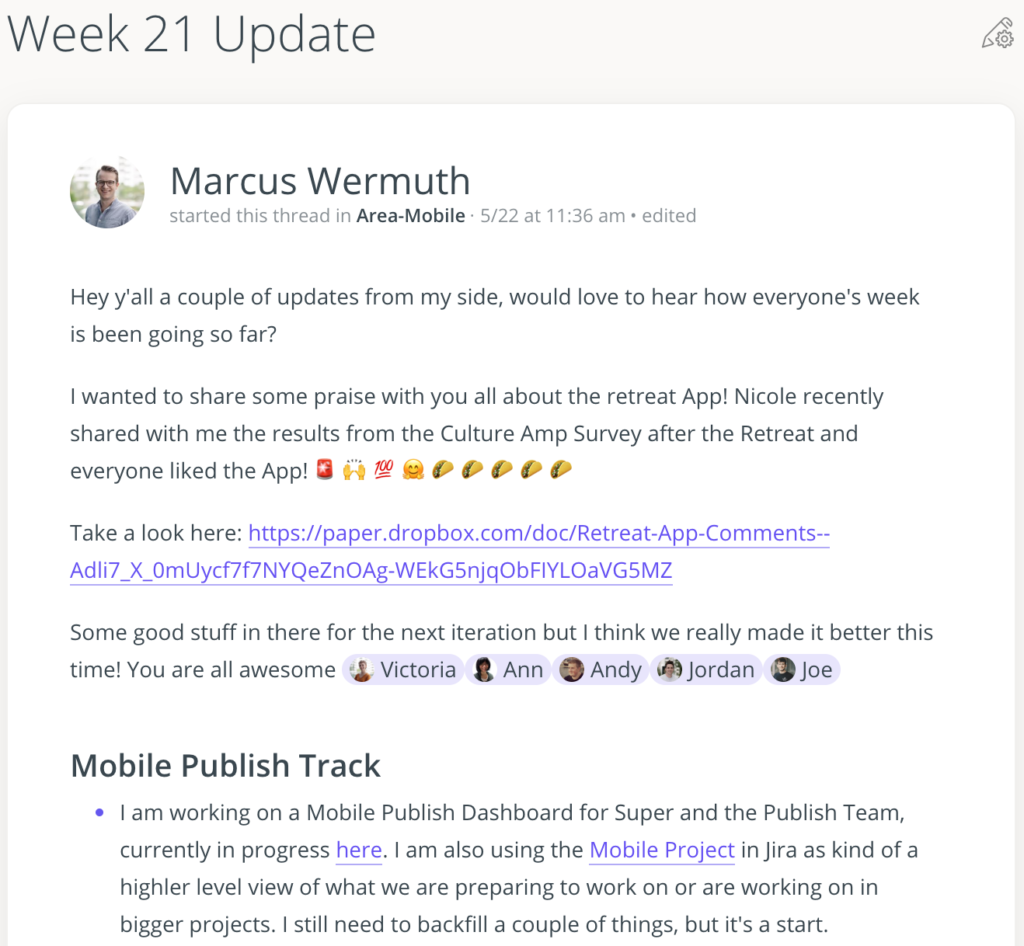
What Happened When Our Team Switched to Only Asynchronous Meetings
With any team, there’s usually the need to sync up.
This usually takes the form of a meeting – or a video call, for those of us on remote team. On the mobile team at Buffer, this is what it looked like for us for a long time.
We had a video meeting of about 45 minutes every week where we got face-time as a team, got on the same page about work, talked though blockers and challenges, made decisions, and updated one another.
While the format of the meetings changed and adapted over time, we attended these “Mobile Syncs” steadily. Our agendas, which we kept in Dropbox Paper, generally took the following format:

This worked great for us – until recently. One of our teammates was spending some time in Taiwan, stretching our team timezones from the US and Europe to APAC. With timezone differences, it was impossible find a time that worked well for everyone.
At first, we discussed whether the majority of the team should keep meeting and record the meeting. That would have meant that one person (likely the person in the most east or west timezone) would only see us in a video recording for months.
It didn’t sound like a great solution to leave someone out and ask them to watch the rest of the team having fun, so we decided against that. Rather than leave anyone out, we decided to lean into asynchronous communication so everyone could participate.
Experiments in asynchronous communication
We’re all open to trying new tools and formats, so we were excited to try out some new things and see how they worked for us.
Experiment 1: Collaborating in Paper doc
One experiment was to use our old meeting document, still putting topics on our agenda, and then discuss those asynchronously using comments. All of this was happening in Dropbox Paper, which ultimately didn‘t work out for us. The comments got to be too much and weren‘t readable or easy to follow.
Experiment 2: Standup tools weren’t a fit
It’s not always the best option to bring in a whole new tool for a specific challenge, but in this case it was needed. First we looked into standup tools, for example standups.io, but realized just by looking at what problem they solve, that they weren‘t the right tool for the job.
Experiment 3: Carrot + Loom almost worked!
The first tool we tried was Carrot, which allowed us to divide things into areas, create topics, and thread comments on those topics. We created a specific “Mobile Sync” area where we would add our thoughts on Thursday, our usual “Mobile Sync” day.
Paired with this, we sometimes linked a recorded video using Loom, talking through some topic or sharing our screen the way we might do on a call. This was a really great way to organize our thoughts, and collaborate with ideas. It was also searchable, so it was easy to find something referenced in the past. As a bonus, the team who created the tool was really receptive whenever we reached out to them with any questions or suggestions!

Our biggest realization here was the importance of notification control. Carrot had some great settings, but ultimately it wasn’t what we needed for the way we were using it. We didn’t want to be overwhelmed by notifications; this was meant to replace a 45-minute meeting once a week. At the same time, many of us were worried about missing something important in a comment we didn’t see.

Experiment 4: Threads was a perfect fit
Around this time, Buffer started experimenting with Threads as a communication tool. As a company, we were looking for a calmer, more timezone-inclusive place for longer discussions to compliment our Slack chatter. This experiment was getting started right as we were noticing our pain points with the previous tool, so it felt right to try moving our “syncs” to Threads. We’ve been there ever since.
We started off with a similar format, where each topic had its own “thread.” This felt good, but it wasn’t the same as a weekly sync. Each thread was a place to discuss a particular topic, rather than a weekly gathering place. We still make separate threads for some topics outside of our syncs, but our weekly meeting space has adapted.
Now, every week we create a Thread on Thursday (our previous “sync day”) where we discuss things for that week. We’re able to divide topics by headers, add our own comments, and comment on others’ comments. We’re able to easily see if there’s anything new to catch up on without too many notifications. We’re even able to mark something to follow up on later if we saw it and don’t want to forget!

What we learned from leaning into async
There are many things we learned throughout our journey with asynchronous communication about what works well and what doesn’t, including plenty of additional benefits beyond timezone flexibility that we had never predicted.
Benefit: Self-documented meetings (no notetaker needed)
By having much of our communication in writing, we’ve basically created self-documented meetings.
You don’t need to worry about meeting notes or catching someone up who wasn’t able to make it if everything is automatically in writing. Alongside that, it means that everything shared is also searchable. You don’t need to worry about forgetting what a team member said two weeks ago; you can look it up if you can remember enough to be able to search for it.
This also allows for reading and understanding at your own pace. If there’s information that’s redundant to you, you can breeze through it. If something is new or more complex, you can take your time making sure you understand everything. It’s respectful of everyone’s time that way.
With this realization, we’ve leaned away from recorded videos. While videos are great for some face time and pointing things out in a screen share, when the benefits it provides aren’t needed, we default to text-based communication.
Benefit: More opportunities for quiet voices
In many teams there are a combination of voices, some quieter and some more assertive. Having this diversity on a team is really beneficial, but can make it hard for everyone to be heard. Quiet voices can find it harder to find a space to interject their thoughts, or prefer to take time to think about their response before communicating it, risking the topic ending before the thought is shared.
Text communication doesn’t discriminate against this difference in communication style. Everyone can share their ideas at their own pace, and the reader never knows how long it might have taken to put thoughts into words. There’s no waiting for turns, and order is more often determined by who is online when, and what time in their schedule they have blocked out for messages.
Lack: Face time
All this said, we know these “asynchronous syncs” are not a replacement for the valuable face time you can get with a video call.
While we each have our own schedules of individual calls with each other, we’ve found that we want to reintroduce some face time across the whole team. Our current experiment is a weekly 30-minute call where we talk about what’s going on in our lives and discuss a single question that we’ve decided on earlier in the week. (“Is there any way you feel that we could collaborate better as a team?” is one example.)
We haven’t been doing this long enough yet to share concrete results, but what we’ve found so far is that this format helps keep the chat personal. We have a relaxed start to bring up anything that’s fun to share, then we discuss a single topic without worrying that we need to get to the next agenda item, allowing us to dig deep. We’ll continue to iterate on this format as we find what works well for us.
Over to You!
Even though our whole team is now in reachable timezones again, we’ve stuck to our weekly Threads instead of going back to video syncs. We find so much value in how this method respects people’s time and voices, while documenting any decisions we make. The flexibility we’ve gained through this experiment was well worth the challenges we went through along the way.
Is there anything here that resonates with you and your team? What have you found that works well for communicating across time zones? I’d love to hear more!
Huge thanks to Marcus and the rest of the mobile team for helping me put these thoughts together.
Try Buffer for free
140,000+ small businesses like yours use Buffer to build their brand on social media every month
Get started nowRelated Articles

In this article, the Buffer Content team shares exactly how and where we use AI in our work.

With so many years of being remote, we’ve experimented with communication a lot. One conversation that often comes up for remote companies is asynchronous (async) communication. Async just means that a discussion happens when it is convenient for participants. For example, if I record a Loom video for a teammate in another time zone, they can watch it when they’re online — this is async communication at its best. Some remote companies are async first. A few are even fully async with no live ca

Like many others, I read and reply to hundreds of emails every week and I have for years. And as with anything — some emails are so much better than others. Some emails truly stand out because the person took time to research, or they shared their request quickly. There are a lot of things that can take an email from good to great, and in this post, we’re going to get into them. What’s in this post: * The best tools for email * What to say instead of “Let me know if you have any questions” a